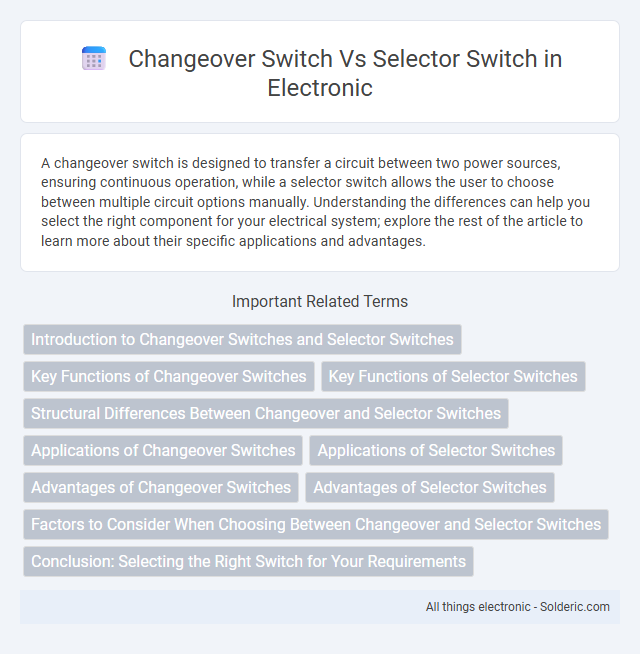A changeover switch is designed to transfer a circuit between two power sources, ensuring continuous operation, while a selector switch allows the user to choose between multiple circuit options manually. Understanding the differences can help you select the right component for your electrical system; explore the rest of the article to learn more about their specific applications and advantages.
Comparison Table
| Feature | Changeover Switch | Selector Switch |
|---|---|---|
| Function | Switches between two power sources or circuits | Selects one circuit from multiple options |
| Usage | Power supply transfer in electrical systems | Equipment control and circuit selection |
| Positions | Typically 2 positions | Multiple positions (more than 2) |
| Application | Backup power switching (e.g., mains to generator) | Mode selection in control panels and devices |
| Operation | Mechanical or electrical switching | Rotary or push-button operation |
| Common Types | Manual and automatic changeover switches | Rotary selector switch, toggle type |
Introduction to Changeover Switches and Selector Switches
Changeover switches and selector switches serve distinct roles in electrical circuits by facilitating control over different power sources or operational modes. A changeover switch allows seamless transfer between two power sources to ensure uninterrupted power supply, commonly used in backup power systems. Selector switches enable users to manually select one of several electrical circuits or functions, often found in control panels for machinery and equipment.
Key Functions of Changeover Switches
Changeover switches primarily enable the seamless transition of electrical circuits between different power sources, ensuring continuous operation without interruption. They facilitate the manual or automatic selection between mains power and backup generators, enhancing system reliability and safety. Key functions include isolating electrical loads, preventing back-feed, and maintaining uninterrupted power supply during source switching.
Key Functions of Selector Switches
Selector switches primarily function to manually control different electrical circuits by allowing users to choose between multiple operational modes or settings. They enable seamless selection of specific circuit paths, enhancing flexibility and safety in industrial control panels. Your control system benefits from the precise and straightforward operation enabled by selector switches, making them essential for tasks requiring reliable mode switching.
Structural Differences Between Changeover and Selector Switches
Changeover switches feature a single input connected to one of several outputs, enabling the transfer of power between two circuits, whereas selector switches allow you to choose one circuit from multiple inputs with a rotating or push-button mechanism. Changeover switches typically have a more robust construction to handle higher load currents and ensure seamless transition without interruption. Selector switches incorporate multiple positions with clear detents for precise user selection, often used in control panels for selecting different operational modes.
Applications of Changeover Switches
Changeover switches are widely used in industrial and commercial electrical systems to transfer power supply between two sources, ensuring uninterrupted operation in case of a power failure. These switches are essential in applications such as backup generator systems, automatic transfer switches, and motor control panels, where reliable switching between power sources is critical. Your system's safety and continuous functionality depend on the efficient performance of changeover switches in these scenarios.
Applications of Selector Switches
Selector switches are commonly used in applications requiring manual control to select different operational modes or functions within industrial machinery and electrical panels. Their design suits settings such as motor control centers, process control systems, and distribution boards, where users need to switch between circuits or equipment safely and efficiently. Your control system benefits from the reliable positioning and clear indication provided by selector switches, enhancing operational flexibility and safety.
Advantages of Changeover Switches
Changeover switches offer superior reliability and safety by allowing seamless transfer of power between two sources without interruption, making them ideal for critical applications such as backup power systems. Their robust design facilitates easy maintenance and prevents overloads by ensuring only one power source is active at a time. Compared to selector switches, changeover switches provide enhanced durability and clear operational status, reducing the risk of electrical faults and improving overall system efficiency.
Advantages of Selector Switches
Selector switches offer superior simplicity and ease of use, reducing operator error and maintenance requirements. Their compact design enables seamless integration in control panels where space is limited, enhancing system organization. High durability and reliability under frequent switching conditions make selector switches ideal for industrial and automation applications.
Factors to Consider When Choosing Between Changeover and Selector Switches
When choosing between changeover switches and selector switches, consider the application's electrical load requirements and switching frequency, as changeover switches are ideal for seamless transfer between power sources, while selector switches excel in selecting among multiple circuits. The level of automation and control needed plays a crucial role, with changeover switches often used in automatic transfer switch systems, whereas selector switches provide manual selection and indication. Durability, contact configuration, and compliance with safety standards are essential factors to ensure reliability and proper functionality in specific industrial or commercial environments.
Conclusion: Selecting the Right Switch for Your Requirements
Choosing between a changeover switch and a selector switch depends on the specific application needs and operational requirements. Changeover switches are ideal for transferring power between two sources, ensuring seamless power backup and safety, while selector switches provide multiple position options for controlling various circuits or functions in complex systems. Evaluating factors like load capacity, switching frequency, and control complexity helps select the most suitable switch for efficient and reliable electrical system performance.
changeover switch vs selector switch Infographic

 solderic.com
solderic.com